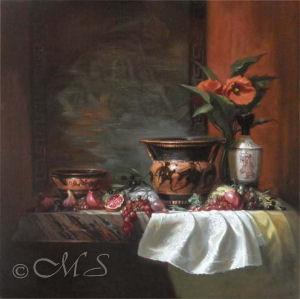
30×30 inches, Oil on Linen
© Margret E. Short, OPA, AWAM
Specifically, the focus is black/red figure vase painting that was in its apogee at about 480-430 BCE. During this time, the Greeks had many pigments available to them. Not only did they have the usual earth pigments such as umbers, ochre, and red iron oxides, but also, vermilion (from China), natural cinnabar, and Egyptian blue and green frit imported from Egypt. This painting evolved after months of research into this period in Greece.
Incorporated into the composition are olives, pomegranates, grapes, marble, figs, period vases and jars, poppies, and a tapestry with the figure of Athena who was the goddess of everything in Greece. The white brocade cloth is representative of the flowers of the hemlock, which poisoned Socrates. [Read the Project Blog]
